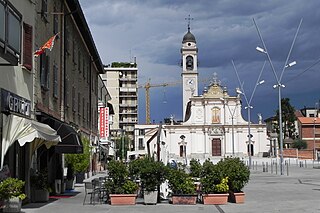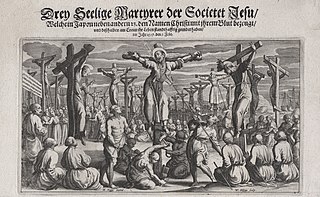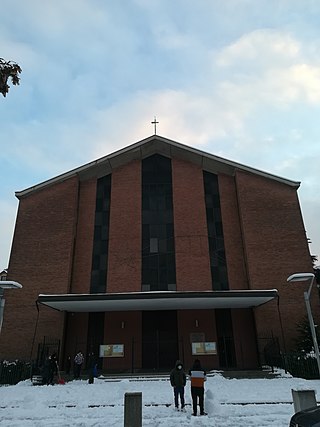
Canonization is the declaration of a deceased person as an officially recognized saint, specifically, the official act of a Christian communion declaring a person worthy of public veneration and entering their name in the canon catalogue of saints, or authorized list of that communion's recognized saints.

Fra Angelico, OP was a Dominican friar and Italian Renaissance painter of the Early Renaissance, described by Giorgio Vasari in his Lives of the Artists as having "a rare and perfect talent". He earned his reputation primarily for the series of frescoes he made for his own friary, San Marco, in Florence, then worked in Rome and other cities. All his known work is of religious subjects.

Peter of Verona, also known as Saint Peter Martyr and Saint Peter of Verona, was a 13th-century Italian Catholic priest. He was a Dominican friar and a celebrated preacher. He served as Inquisitor in Lombardy, was killed by an assassin, and was canonized as a Catholic saint 11 months after his death, making this the fastest canonization in history.

Antonio di Benedetto Aquilo degli Aquili, known as Antoniazzo Romano, was an Italian Early Renaissance painter, the leading figure of the Roman school during the latter part of the 15th century. He "made a speciality of repainting or interpreting older images, or generating new cult images with an archaic flavor", in particular by very often using the gold ground style, which was unusual by this period.

The Basilica of San Domenico is one of the major churches in Bologna, Italy. The remains of Saint Dominic, founder of the Order of Preachers (Dominicans), are buried inside the exquisite shrine Arca di San Domenico, made by Nicola Pisano and his workshop, Arnolfo di Cambio and with later additions by Niccolò dell'Arca and the young Michelangelo.

Cinisello Balsamo is a comune (municipality) of about 75,200 inhabitants in the Metropolitan City of Milan, in the Italian region of Lombardy, about 10 kilometres (6 mi) northeast of Milan city center.

The Diocese of Brescia is a Latin diocese of the Catholic Church in the ecclesiastical province of the Metropolitan Archdiocese of Milan, in Lombardy.

The Martyrs of Japan were Christian missionaries and followers who were persecuted and executed, mostly during the Tokugawa shogunate period in the 17th century. The Japanese saw the rituals of the Christians causing people to pray, close their eyes with the sign of the cross and lock their hands together – this was seen as psychological warfare against the Japanese and this was punished as such. More than 400 martyrs of Japan have been recognized with beatification by the Catholic Church, and 42 have been canonized as saints.

Giacomo Salomoni, OP was an Italian Catholic priest and a professed member of the Order of Preachers. He was a noted ascetic known for being prone to ecstatic states on a frequent basis; he served as a prior of several convents until he settled in Forlì, where he remained until his death.
Galeotto Roberto Malatesta (1411–1432) was an Italian condottiero and blessed of the Catholic Church.

Luke Spicola was an Italian Catholic priest belonging to the Order of Friars Preachers. The Catholic Church venerates him as a blessed and celebrates his memory on April 22.
Thomas of Tolentino was a medieval Franciscan missionary who was martyred with his three companions in Thane, India, for "blaspheming" Muhammad. His relics were removed to Quanzhou, China, and Tolentino, Italy, by Odoric of Pordenone. He is now venerated as a saint by the Roman Catholic Church, with his feast day on April 9.

Andrea Grego was a Dominican friar and preacher. He is venerated as a Blessed in the Roman Catholic church.

The Assassination of Saint Peter Martyr or The Martyrdom of Saint Peter of Verona is a 1530–1535 oil on canvas painting by Moretto da Brescia, now in the Sala dell'Esedra in the Pinacoteca Ambrosiana in Milan.

San Domenico, also called Santa Maria la Grande is a Roman Catholic church and active convent located on piazza San Domenico in the quartiere di Santa Maria la Grande, in Catania, region of Sicily, Italy. The church stands about two blocks north of the church of Sant'Agata la Vetere on via Santa Maddalena. The neoclassical-style, late 17th-century church houses a few prominent altarpieces that survived the 1693 catastrophe in Catania.

The sanctuaryof San Martino Vescovo in Balsamo is a religious building in the city of Cinisello Balsamo, located at the confluence of Via San Saturnino (south) and Via San Martino (north), facing the Avenue of Remembrances. Historically, it has also been the reference church of the local Balsamese community for centuries, around which the city's built-up area developed until the early 20th century.

The Church of San Martino is a Catholic religious building located in Cinisello Balsamo, in Piazza Soncino, overlooking Villa Casati Stampa. It is the main church in the Balsamo area.


















